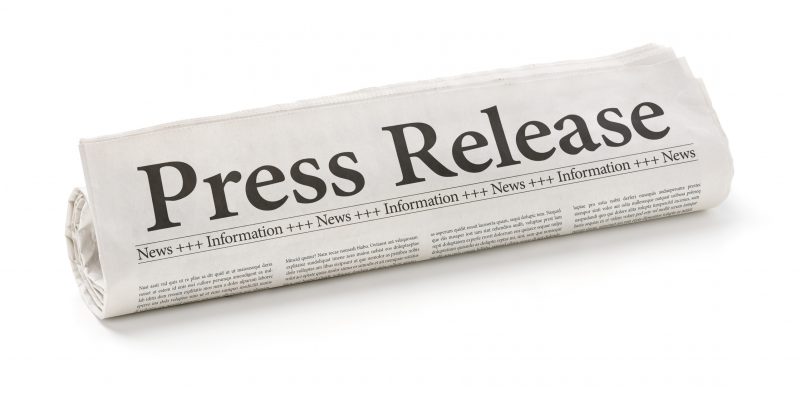Writing a compelling press release is not an easy task but, when mastered, it is a fantastic addition to a person’s skill set. In the world of media relations, a press release is a powerful tool that will catch the attention of journalists and the media, which ultimately attracts clients and consumers. But what does a good press release look like? What should it include? What format should it have? And how can I maximise exposure?
These are all good questions and we are here to help answer them. A compelling press release follows specific guidelines and formatting and we are here to break them down for you. Here are our top five tips.
Preparation is Key
An important factor to consider before writing your press release is your target audience. You not only want to attract the right attention, you also want to keep your readers engaged throughout. Remember the medium in which you are posting your press release will impact your content. For example, if your niche is teenage fashion, you could be less likely to pitch to Vogue Australia as this is more of a sophisticated fashion magazine, aimed at 25-54-year-olds (see here). It could be better to target Millennials and Gen Z readers through other media outlets. Consider who your audience is and how you are trying to target them and tailor your content accordingly.

- Research, research, research
Research is critical to good PR. If you’re sending out a press release to a journalist, you should know what beat that journalist covers, what style of stories they tend to accept, and ideally what time of day is best to contact them.
You’ll need a deep understanding of the publication you’re pitching to, so it’s critical that you spend some time and energy fully immersing yourself in each publication’s content. Sign up to their email lists, follow their social media accounts and speak to anyone who might have some insider insight. Find out what time they send their newsletters, and what their daily deadlines are, so you can avoid hassling them at the wrong time.
- Use a Standardised Structure
When it comes to structuring your press release, there is a set structure that should be used. By following this, you will appear both experienced and professional and journalists will be able to read your content with ease. Let’s break down this structure.
Heading – this is the first thing that your audience will read so it should be short, concise and captivating.
Lead – consider the 5 W’s in this section; what you are writing about, who is involved, when and where it happened and why it is significant.
Source – citing sources will boost the credibility of your press release and enable your audience to trust your content.
Essentials – give enough details to engage your readers and get potential journalists excited about your content.
Quotes – showing the perspective of others in your content can make the text more interesting and engaging.
Contact – adding your contact details is essential for journalists to reach out to you.
Boilerplate – a one-paragraph description of your company and important business information.
- Perfect Formatting
Your press release should be straightforward, easy to follow and eye catching. Readers need to be visually stimulated in order to stay engaged and focused. Consider whether to showcase it in a PDF, plain text, interactively or other, keeping in mind your target audience.

- Short might be snappy, but it’s not helpful…
I always advise businesses to go against the popular opinion of keeping releases ‘short and snappy’. My mission is to make a journalist’s job easier by giving them a story that they are happy to cover, and then giving them as much information as they need to do that well. It’s far easier for them to pick out the bits of a release they want than to chase you for more information.
As I write the release, I’m anticipating what they will want to know, so I can include as much of it as possible in the release itself. For example, ‘yes, high-resolution images or b-roll footage is available’. ‘Yes, I have the following people available for interview, and case studies are available.’ ‘Yes, I have included additional information such as a bio and a lengthier background below.’
This year has been incredibly hard on journalists, who are all working longer hours, tackling intense, life-changing stories and in many cases, are being paid less to do more work. Do whatever you can to make their lives easier.
- Keep it Newsworthy and Authentic
For a compelling press release, it is essential to ensure your story is new and interesting. If a journalist does not consider your story as newsworthy then it won’t get the coverage that you desire. Janet Murray from The Guardian advises to watch or listen to the publications in which you’d like coverage in to understand what stories they typically cover and tailor your content accordingly. Once established, ensure your perspective is clear from the beginning and write with authenticity.
- Optimise the Exposure
When it comes to releasing your public relation news release, ensure that you are maximising the exposure. Target specific journalists and send them personalised messages instead of mass sending. Reach out to them in advance of your press release going live ‘under embargo’ to give them some time to craft their story on your content.
Going beyond the press release
Although press releases are a great tool under specific circumstances, most of the time, they’re simply not going to cut it. Unless you’re selling a hard news story with a headline-worthy hook, it’s likely that your release will simply go straight in the (virtual) bin. In 2020, journalists typically only have time for news that relates in some way to current events, or is a standalone story in its own right. If you’re questioning whether your story is ‘newsworthy’ enough, it’s probably not.

Don’t worry, though because even if you don’t have any worthwhile news to share, there are still multiple ways to achieve positive media coverage for your business. These include advice or opinion articles, otherwise known as contributed editorial, or bylined articles. These are articles providing helpful advice, how-to tips, bold commentary, and explanations on a particular topic.
In a bylined article, you are attributed as the author with your name attached. Often your company name, website, a short bio and a photo of you are also included in the author line, or at the bottom of the article. These are great for business leaders in particular, because it positions you as an expert, guarantees what will be said, and includes information that encourages the reader to take action.
If you’re planning on writing an opinion-based byline, consider topics including busting a particularly prevalent myth in your industry, exposing money-wasting schemes, weighing in on issues of the day or creating some kind of debate.
Finally, look for feature and interview opportunities where possible. However, don’t simply approach a journalist offering ‘an interview’ – instead, look for genuinely useful ways that you can fit into a current news story or ongoing debate. Search out the journalists who are already writing about a topic you know inside out, and look for gaps in their reporting or ways you can add even more value to their work.
SourceBottle is a fantastic low-cost service that identifies interview requests and media call outs, looking for talent or information. This gives you the opportunity to participate in upcoming media reports and features. A PR agency with good relationships with key media can also pitch you as a spokesperson for interviews, or as a case study to be involved in scheduled feature articles and news pieces.
Ultimately, if you have a good story to tell, a journalist does not care if you tell it over email, over the phone, or via carrier pigeon. If a press release is the best way to tell your tale, then don’t let trends or half-baked PR theories stop you. After all, it’s the content of the release, not the release itself, that matters.
Maximise the Impact of Your Next Public Relations News Release
Maximise every public relations news release by utilising the services of experts. For an honest, proactive and reliable PR services in Sydney that guarantees coverage, contact the best boutique PR Agency in Sydney, Pure Public Relations. Ensure every press release reaches its optimum potential and let your business thrive with our guidance. Get in touch today to get a good result PR!

